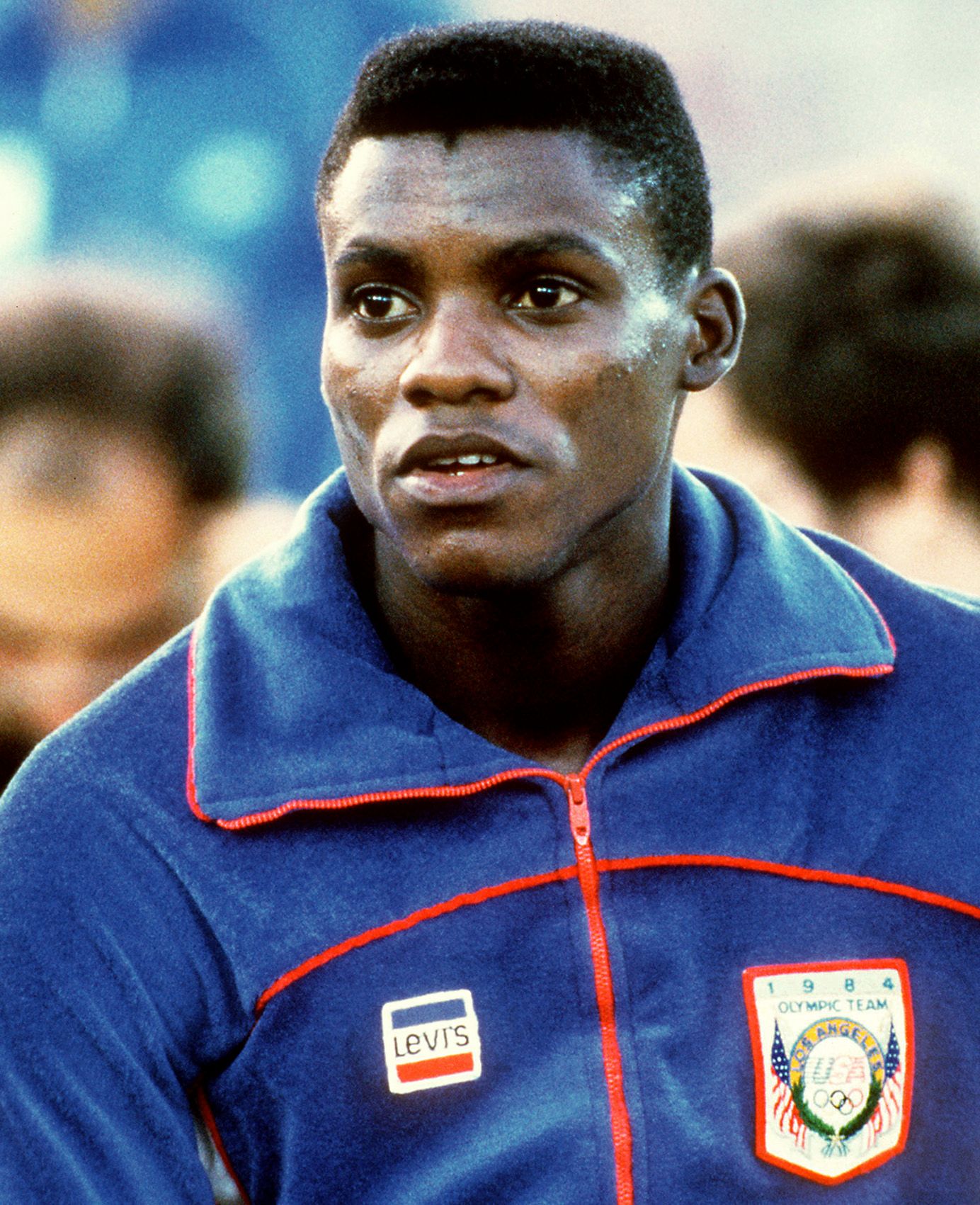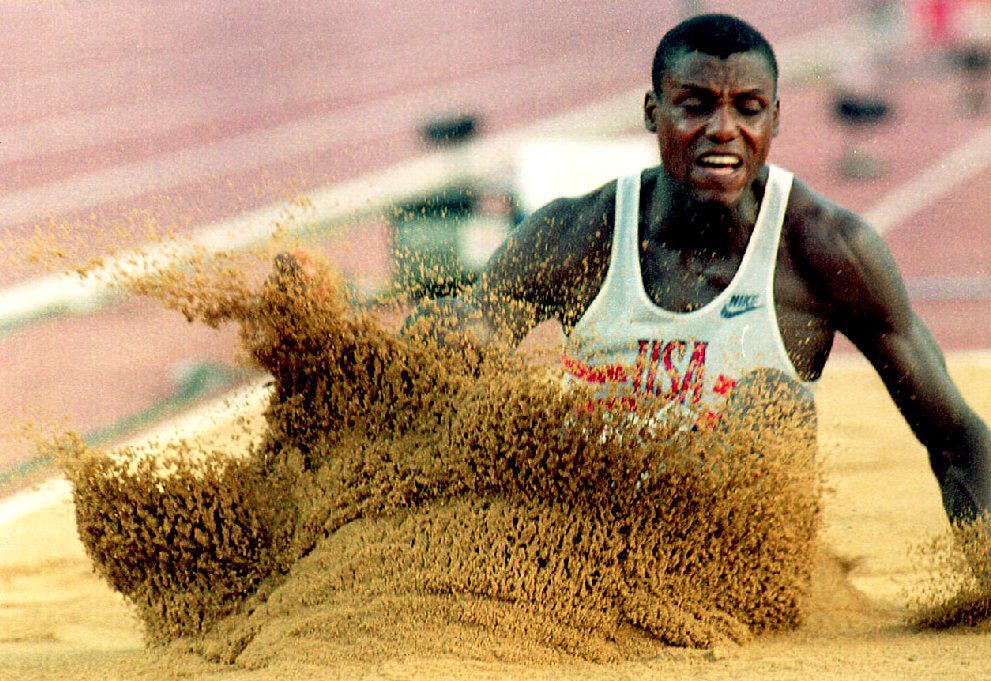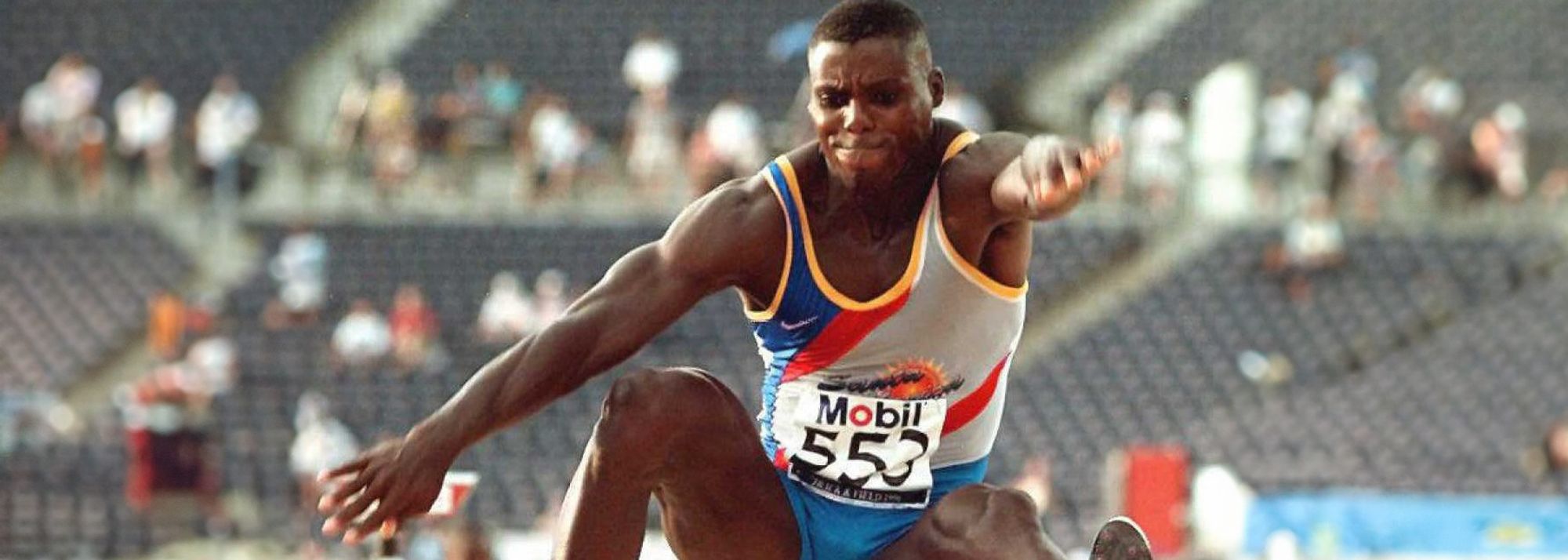Carl Lewis (© AFP / Getty Images)
For Frederick Carlton Lewis, the long jump competition at the 77th Millrose Games proved to be his first big test of 1984, the year that would become his annus mirabilis, his most marvellous year.
Eight months out from the home Olympics in which he hoped to emulate the quadruple golden deeds of Jesse Owens, the peerless long jumper and sprinter found himself in an unaccustomed spot of bother, staring at the prospect of defeat on the grand indoor stage of New York’s Madison Square Garden on 27 January 1984.
After five rounds, the US phenomenon who had had swept to emphatic victories in the long jump and 100m at the inaugural World Athletics Championships in Helsinki the previous year, in addition to anchoring his country to victory in the 4x100m, was lying in second place with just one attempt remaining. His 30-meeting winning streak in what he considered to be his premier discipline was under imminent threat.
“What if you’re in this situation at the Olympic Games?”
All night long, Carl Lewis had been struggling to find his rhythm on a truncated plywood indoor runway that had two loose boards at the start. He was also suffering from the lingering effects of a cold.
He opened with 6.77m - possibly his poorest mark since he and his sister Carol, the future US record-holder, used to jump into a long jump pit they made with sand left over from a patio their father, Bill, built at the rear of the family home in the Philadelphia suburb of Willingboro, New Jersey. (The Lewis kids had caught the long jump bug when their parents opened Willingboro Track Club. “The long jump pit was our babysitter,” wrote Carl in his autobiography Inside Track. “Most of the time, we played in the sand, building castles.”)
The new king of the long jump world improved to 8.21m in round two at the Millrose meeting and then 8.30m in the penultimate round but he was still 8cm shy of pole position. That was held by Larry Myricks, winner at the 1979 World Cup in Rome and the last man to beat Lewis – at the US Indoor Championships in February 1981.
As Lewis prepared to take his sixth-round attempt, rocking back and forth on his heels at the head of the runway halfway up lane one on the banked track – he could not help projecting his mind ahead to the Los Angeles Olympics. It had long been his intention to earn a lasting place in track and field history by emulating Owens’ haul of long jump, 100m, 200m and 4x100m gold from the 1936 Games in Berlin.

Carl Lewis in Los Angeles in 1984 (© AFP / Getty Images)
Asked what he had been saying to himself at that critical moment, in front of an expectant home crowd, Lewis replied: “I had to tell myself, ‘What if you’re in this situation at the Olympic Games?
“’You have to be able to do it. You have to be able to come from behind. A true champion can win in any way’.”
The US golden boy proceeded to charge down the runway in textbook style, his long levers pumping in perfect piston-fashion. He hit the board flush on, launched a take-off of NASAesque precision, soaring through the air with a lightning-quick, silken double hitch-kick.
Resplendent in Santa Monica Track Club vest and luminous orange shorts, as though dressed for a day at the beach, he raised his arms in triumph as soon as he cut the sand. The distance was a whopping 8.79m, or 28 ft 10¼ in imperial, US-favoured, terms.
Lewis had preserved his winning streak by a margin of half a metre. He had also broken the world indoor record by 20cm. His own world indoor record: 8.56m, which he set at East Rutherford, New Jersey, in 1982.
That performance had trumped the 8.49m he jumped at the South West Conference Indoor Championships in Fort Worth, Texas, in February 1981. The previous two holders of the record were Myricks, with 8.38m from 1980, and Bob Beamon, with 8.30m from 1968, the year in which he uncorked his stunning 8.90m outdoor world record at the Mexico Olympics.
Lewis’ 8.79m was the joint second-best long jump of all time, matching the distance he achieved at the Indianapolis TAC Championships in June 1983. That, however, had been assisted by a following wind of 1.9m/s.
The greatest jump of all time?
Given the conditions at Madison Square Garden – indoors at sea level with no wind and a rickety wooden runway of abbreviated distance – there was a strong case for arguing that Lewis’ indoor leap was the greatest of all time. At the Mexico City Olympics in 1968, Beamon’s out-of-this-world 8.90m had benefitted from a tail wind bang on the allowable limit, at 2.0m/s, and an altitude of 2,240m.
“We figured very conservatively that Beamon’s jump was helped six inches to a foot (15cm-30cm) by the lowered air resistance of Mexico City and the aiding wind,” said Bert Nelson, editor of Track and Field News. “That would make Carl’s jump worth at least 29ft 6¼in (9.00m) under the same conditions as Beamon’s.”
Garry Hill, the magazine’s managing editor, went farther. “When you consider the short runway and the hard landing pit, it sounds like well over 30 feet (9.14m) to me,” he estimated.
In The New York Times, another great chronicler of track and field matters in the United States and beyond, Jim Dunaway pointed out: “In terms of other events as compared by the IAAF’s scoring tables, a 9.00m long jump is equivalent to a mile run in 3:40 (compared to the present world record of 3:47.33), or a 100m dash in less than 9.58 (compared to the world record of 9.93).”
Better than Usain Bolt’s future feat, in other words.
According to the most recent World Athletics scoring tables, Bolt’s 9.58 is worth 1356 points. A 9.00m long jump would be worth 1357 – the same as an 18.79m triple jump.
“I also think I can jump 30 feet (9.14m)”
Lewis was just happy that he had managed to snatch a victory from the jaws of defeat. “Being able to come from behind is as important as winning,” he said. “You’ve got to be mentally tough.
“I had to respond. I had to jump well, and I had one jump to do it. I have to thank Larry for that.
“I also have to thank my coach, Tom Tellez. After my fifth jump, he said I was too close to the board and told me to move the start of my run up back a foot. I did, and it worked.
“I’m really pleased that I came through. Now I think I can break the world record outdoors this year. I also think I can jump 30 feet (9.14m).”
Unfortunately for Lewis, it was not to be.
In the rest of his glittering career in the No.1 Olympic sport, outdoors and in, he only bettered 8.79m twice. In that epic final at the 1991 World Athletics Championships in Tokyo, he jumped 8.84m and 8.87m but took silver behind the 8.95m with which his US teammate Mike Powell exceeded Beamon’s world record – ending his winning streak after 10 years and 65 victories.

Carl Lewis (© AFP / Getty Images)
An 8.91m mark in the same competition was achieved with a 2.9m/s following wind. A jump considered by most in attendance to have been comfortably beyond 9.00m in Indianapolis in 1982 had drawn a red flag, even though Lewis left no mark on the plasticine. He reckoned he had hit the 30ft mark, 9.14m.
Still, Lewis did complete his Olympic quadruple in the LA Coliseum in 1984, winning the long jump by 30cm with his opening effort, 8.54m. He won four successive Olympic long jump titles, finishing his career with nine Olympic golds in total, equalling Paavo Nurmi’s record track and field haul.
He also claimed eight gold medals from the World Athletics Championships and was named as Male World Athlete of the 20th Century.
And, as indoor track and field enters a new era as short track competition, the 8.79m that Carl Lewis leapt at Madison Square Garden four decades ago remains unchallenged as the greatest long jump ever achieved under cover.
Simon Turnbull for World Athletics Heritage





